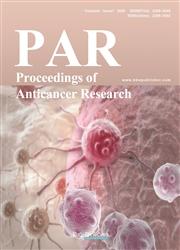Clinical Application of Circulating Tumor Cells in Evaluating the Effect of Chemotherapy in Advanced Non-Small Cell Lung Cancer
引用次数: 0
Abstract
Objective: To explore the value of circulating tumor cells in evaluating the effect of chemotherapy for advanced non-small cell lung cancer. Methods: Sixty-two patients with advanced non-small cell lung cancer who received chemotherapy in the Affiliated Hospital of Hebei University from January 2018 to December 2021 were selected as the research subjects. The positive rate of CTCs after two weeks of chemotherapy and four weeks of chemotherapy as well as the evaluation of imaging efficacy were observed and analyzed. Results: Based on the clinical data of the patients, the positive rate of CTCs in male patients was 77.78%, that in female patients was 80.77%, that in patients ? 60 years old was 78.13%, that in patients < 60 years old was 76.67%, that in squamous cell carcinoma was 79.31%, that in adenocarcinoma was 78.79%, and that in highly differentiated, moderately differentiated, and poorly differentiated + undifferentiated CTCs was 66.67%, 84.21%, and 90.91%, respectively; there was no statistical difference in the general data. The positive rate of CTCs was 88.71% before chemotherapy and 66.13% after two weeks of chemotherapy, in which the difference was statistically significant; the positive rate of CTCs four weeks after chemotherapy was 59.68%, which was statistically significant compared with that before chemotherapy; however, there was no significant difference between two weeks after chemotherapy and four weeks after chemotherapy. After chemotherapy, 35 patients had CR+PR, 19 patients had SD, and 8 patients had PD. The proportions of CR+PR, SD, and PD in the imaging evaluation results were 56.45%, 30.65%, and 12.90%, respectively. After kappa consistency test, it was found that the consistency was good. Conclusion: CTCs can be used as one of the indicators to evaluate the effect of chemotherapy for advanced non-small cell lung cancer. The results are consistent with those of imaging evaluation. The detection of CTCs can be widely used as one of the clinical indicators.循环肿瘤细胞在评价晚期非小细胞肺癌化疗效果中的临床应用
目的:探讨循环肿瘤细胞在评价晚期癌症化疗效果中的价值。方法:选取2018年1月至2021年12月在河北大学附属医院接受化疗的62例晚期癌症患者为研究对象。观察分析化疗2周和化疗4周后CTC的阳性率及影像学疗效评价。结果:根据患者的临床资料,男性患者CTC阳性率为77.78%,女性患者为80.77%?60岁为78.13%,<60岁患者为76.67%,鳞状细胞癌为79.31%,腺癌为78.79%,高分化、中分化和低分化+未分化CTC分别为66.67%、84.21%和90.91%;一般数据无统计学差异。化疗前CTC的阳性率为88.71%,化疗两周后CTC阳性率为66.13%,差异有统计学意义;化疗后4周CTC阳性率为59.68%,与化疗前比较有统计学意义;然而,化疗后两周和化疗后四周之间没有显著差异。化疗后,35例患者出现CR+PR,19例患者出现SD,8例患者出现PD。CR+PR、SD和PD在影像学评估结果中的比例分别为56.45%、30.65%和12.90%。经过kappa一致性测试,发现一致性良好。结论:CTCs可作为评价晚期癌症化疗效果的指标之一。结果与影像学评价结果一致。CTC的检测可以广泛用作临床指标之一。
本文章由计算机程序翻译,如有差异,请以英文原文为准。
求助全文
约1分钟内获得全文
求助全文

 求助内容:
求助内容: 应助结果提醒方式:
应助结果提醒方式:


